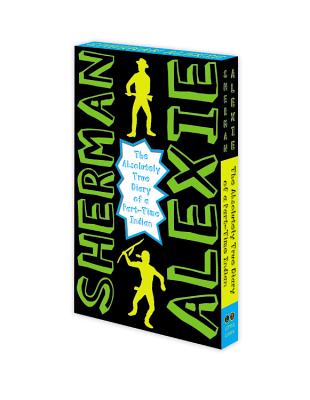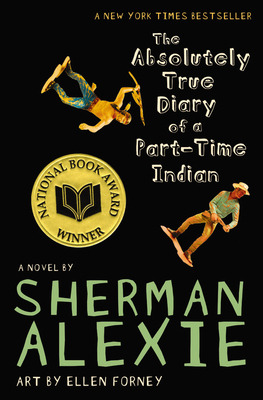Today (June 16, 2016), I'm adding this: check out Sarah Park Dahlen's "Who is 'The Other?'" in THE EARLY READER IN CHILDREN'S LITERATURE AND CULTURE, edited by Miskec and Wannamaker, published by Routledge Press.
________________________
SATURDAY, JUNE 18, 2011
In comments to "Chief Read Heap Much" on June 16, 2011, Wendy submitted a comment about Lenore Look's Alvin Ho: Allergic to Birthday Parties, Science Projects, and Other Man-Made Catastrophes (2010). The illustrations are by LeUyen Pham. It is pitched at children in 2nd through 4th grade.
Here's what Wendy said:
Have you all read the latest Alvin Ho book? There's an almost astonishing "playing Indian" theme. I can't understand it on multiple levels. Why did the author think this is something kids still do? As an Asian American didn't it seem at all "off" to her? And how on earth did it get past the editors and readers at the publisher? It's a major part of the plot. (My review: http://www.goodreads.com/review/show/126789049)Her comment prompted me to dash over to the library and get a copy. Reading the book, I can see why the Alvin Ho books (I think this is the third one) are appealing and getting starred reviews. In writing and format, it feels a bit like Alexie's Absolutely True Diary. By that, I mean it is a quick read, lot of humor, and cool illustrations throughout. See what I mean?
Engaging writing and cool art, but Wendy is right. Below are summary, excerpts, and illustrations. Beneath the summary is my discussion, in italics.
Summary
In chapter three, Alvin is going down the street and stops at Jules's house because there's a lot of noise coming from his yard. Alvin peers through the bushes and sees that a bunch of kids (he calls them "the gang") are playing "King Philip's War." Alvin tells us that it was the "war between settlers and natives that nearly wiped out all of Massachusetts a hundred years before the American Revolution wiped out everyone else" (p. 35). Here's the illustration on that page:
The child in the bottom right corner is Pinky, playing the part of King Philip. He tells Alvin that it is "settlers against Indians" and that they're practicing for an upcoming birthday party that Alvin doesn't know about:
"Do you have settler gear?" Pinky asked.That night, Alvin makes a wish:
I shook my head no.
"How 'bout Indian gear?"
I shook my head again.
"No wonder you haven't been invited," said Pinky. "No war paint, no moccasins, no fun."
"I wish for the Deluxe Indian Chief outfit with fringe," I said, my breath dripping on the glass. "Complete with bow and arrow and the huge feather headdress that makes you look like a giant bird."In the next chapter, Alvin hopes for the invitation to arrive, but he's sure he actually needs that outfit in order to be invited. He does get an invitation, but it is to Flea's party. She's a girl, and he hates girl birthday parties. His mom wants him to go, and Alvin thinks that if he agrees to go, maybe his mom will get the Deluxe Indian Chief outfit for him:
Having agreed to go to the girl party, he dashes to his room and makes a list of things to do (p. 51):
Get my new deluxe Indian outfit.In subsequent chapters, Alvin continues to think about the party and how much he wishes he could get the outfit and the invitation so he can "play Indian" (p. 85). In chapter 12, he is at the mall with his mom. They are there to buy a present for Flea (her real name is Sophie). At the store, Alvin's mom pulls a box from the shelf and says "Wouldn't she look adorable in this?" and shows him the box (p. 141) :
Eat breakfast in my new deluxe Indian outfit.
Go to school in my new deluxe Indian outfit.
Walk down the street in my new deluxe Indian outfit.
Sleep in my new deluxe Indian outfit.
Play settlers and Indians with the gang.
Go to Hobson's party in my new deluxe Indian outfit.
I was staring straight into the plastic window of the Deluxe Indian Princess outfit with fringe, complete with baby carrier and explorer map and moccasins.Alvin sees that the Deluxe Indian Chief outfit is on the shelf, too, but they aren't there to get something for him, and they don't buy it. As the story continues, Alvin gives up. In chapter thirteen, Alvin is hanging out more with girls than guys. He doesn't like that he is more aligned with the girls and the girl party than the guys and the guy party. At lunch one day, he is sitting with the girls. They're all talking about Flea's party and what they're going to wear to it. Alvin is furious, as he chews on his goldfish crackers and thinks (p. 144):
A man wears steel-toed boots. A man wears work gloves. A man wears war paint. A man wears an enormous feather headdress that makes him look like a giant bird. A man doesn't talk about what he's going to wear. He just wears it.Then, he burps, spraying the girls with chewed up bits of goldfish crackers. The girls are grossed out, and Alvin races out of the cafeteria. Spraying the girls with goldfish, it turns out, is what gets him invited to the party. On the playground, Hobson tells him to bring a present, and to dress as an Indian.
The problem is, he doesn't have the Deluxe Indian Chief outfit. Another problem, it turns out, is that Flea's party and Hobson's party are at the same time. He tells his dad about it, and his dad tells him that he's got a dilemma. Alvin doesn't know what that word means, and he shakes his head. His dad assumes that he's going to do the right thing and go to Flea's party.
The next morning, Alvin gets ready for Hobson's party, and puts on the Deluxe Indian Princess outfit. It doesn't have a headdress, so he makes one out of buttons, ribbons, and one hundred Popsicle sticks.
When the time comes, he heads to Hobson's party. Before he gets there, he runs into the boys in their outfits. Some are settlers in Pilgrim hats and some are Indians. They're practicing for the party because it isn't quite time to be there yet. Alvin joins in the play:
I ducked. Then I gave a loud whoop.Alvin tries to ignore his dad's voice. He thinks of how fabulous his outfit is, and that playing settlers and Indians is great, but he doesn't feel wonderful. Finally, he decides he has to do the right thing: go to Flea's party instead. He takes off the outfit, puts it in a box and goes to Flea's party where, having eaten a lot of ice cream that gives him gas, he "explodes," excuses himself, and goes home. The books ends with "Alvin Ho's Creepy Glossary" of words.
Loud whoops went round and round.
Invisible arrows went up and down.
Indians fell.
Settlers fell.
Indians rose from the dead.
Settlers rose from the dead.
Loud whoops went round and round.
It was terrific!
Then I stopped.
I could hear my dad's voice in my ears. "You know the right thing to do and you do it. No one has to tell you."
Discussion
When I got to the glossary, I thought, "This book needs another glossary entry... STEREOTYPE. And, it needs that word stamped in big letters on the front of the book." From the feathered headdress to the war paint to the war whoops and bow and arrow, all the elements of the stereotyped Indian are in this book.
I want you to imagine a Native parent, reading the book aloud to his or her children. They're having a good time, but then, they get to page 35.
Or, imagine a Native child... All his friends are into a new series about an Asian American kid named Alvin Ho. He decides he'll check it out, too. So he does, and then... he gets to page 35.
Suddenly, the fun of the book is gone. Suddenly, a stereotyped image of you is in your face...
What some people see as harmless fun---dressing up as Indians for a birthday party---is not harmless fun. It is stereotypical, and it is racist. I don't often use that word in my writing. Using it puts up a barrier. Nobody likes to see the word, especially if it can be applied to something they have done.
And what about that party theme.... settlers and Indians?! That's a new one for me, at least in terms of a child's birthday party. What was Look (the author) thinking as she developed the plot? Was she trying to develop authentic play-Indian scenario, and used King Philip's War as the way to bring in some authenticity?
This might seem an in-your-face thing to do, but I'm going to hashtag Look on Twitter and see if she might explain what she was thinking about as she wrote this book. Did she, or as Wendy asks, her editor and readers at Random House not pause a moment and consider whether or not they ought to go forward with this book?
In their review, Kirkus gets it right:
Troubling in this volume, however, is that at the coveted boys’ birthday party, everyone is dressing up as Indians and settlers, and Alvin figures his ticket is a "deluxe Indian Chief outfit." Although there is a brief note in the always-creative glossary regarding the colonization of Native peoples’ land during King Philip's War, there is no textual mitigation of a running joke that seems anachronistic at best--readers may well be left feeling uncomfortable with the stereotype.
I was uncomfortable, and so was Wendy. How about you?
________________________________
Update, 4:24 PM CST, June 18th, 2011
See Sarah Park's blog post about the book. (Thanks, Allandaros, for letting me know the link was not working. I've fixed it.) Sarah wrote, in part:
I’m trying to process this as an Asian American scholar of Asian American children’s literature. How are Asian Americans complicit in perpetuating stereotypes of cultures not our own? Why? And from where (or from whom) do we learn these stereotypes? What makes us think it’s okay?It grieves me that we participate in the denigration of already oppressed cultures, whether intentionally or not (intentionality doesn’t matter – impact matters).______________________________
Update, 8:26 AM CST, June 19, 2011
Lenore Look responded in a comment. I'm copying it here as well:
Hi Debbie, thanks for alerting me on twitter. your comments deserve a more thoughtful reply than 140 characters, so i'll respond here. I'm terribly sorry that my work offended you. But stereotypes are offensive. My intention, as from the first of the series, is to highlight seldom-mentioned historical events/facts that textbooks and popular historians tend to exclude, many of which seem to involve a collective shame. In this case, it was King Philip's War, in which the Native population of New England, already thinned by smallpox and other European diseases, fought viciously against English encroachment and in turn was mercilessly slaughtered by the settlers, who were also nearly wiped out by the fighting. It happened 100 years before the American Revolutionary War and forged the beginning of a new national identity, separate from England, for the colonists. It was a seminal event for the later rebellion, yet when is this ever mentioned in the elementary classroom? Or mentioned anywhere at all?
As for the stereotyped play and costumes . . . well, when kids play "cowboys and Indians" or "settlers and Indians" (being that this is colonial Massachusetts history), that's how i imagined they would play and dress, based on how it's been done in the past and as recently as the Disney Pocahontas craze in the mid-to-late 90s. Politically correct? No. But do kids play politically correctly? No. Should I perpetuate play that is not politically correct? No. But I would not be TRUTHFUL if I were to fabricate a scenario for them that conforms to our current, enlightened-adult sense of how kids should play if that’s not the behavior that we’ve already passed to them. And good writing is about being honest, regardless of how discomforting it might be, especially when echoed in our children's play.
My job as a writer is not to erase unpleasantness, stereotypes, or even racism from a child's world. My job is to hold a mirror to that world and allow them to look at it more directly than they might otherwise. I believe in eradicating stereotypes as much as you, but eradication does not include erasing our shameful portrayal of Natives in the past and pretending that none of it has been passed down.
Are kids supposed to “get” this? I expect they will get what they need to ask about King Philip’s War and about juvenile behavior encouraged by adult-generated culture and props. If not, then the adults who get it, should start the conversation.
Thank you for your close reading of Alvin, and for starting the discussion.
___________________________
Update: 3:08 CST, June 19, 2011:
Thanks, Lenore, for taking time to respond to my questions.
Incorporating history into your books is great, but I'm not sure I understand why you chose King Philips War. You include that war because you think it is fundamental to an American identity. What do you think is the shame in that war? That's where I'm confused. Is it shame over colonization that you think keeps it out of history books? I'm not sure why textbook writers would feel shame at that moment of colonization. They certainly glorify other wars, periods of conquest...
If it is shame over treatment of Native peoples, then, it makes me wonder why you don't feel shame at using shameful stereotypes. You had other choices for a birthday theme. Like a Star Wars one... Or a Harry Potter one! Something more contemporary. Course, both of those might have trademark issues, but I think you get my point.
I think in being "TRUTHFUL" to the way some kids in the US do birthday parties, you're passing that practice on to your readers as an ok thing to do. Nobody in your book says "wait a sec." You leave it up to kids and adults to say "oh, they shouldn't be doing that." You assume the adults are going to use it as a teaching moment, but most of the reviews don't even mention it. Kirkus did, but on GoodReads, Amazon... very rarely is someone saying anything about it. Maybe you had to cue them somehow, via an author's note?
If you're comfortable continuing this conversation, I'd like to know if you and your editor, or you and your illustrator, talking about those stereotypes. What did you say to each other?
---------------------------------------------------
Update, Friday June 24th, 10:06 AM CST
Author Cheryl Savageau tried to submit a comment but Blogger was not working. She submitted to me via facebook. I'm placing it here:
Cheryl Savageau said:
Look is kidding herself if she thinks what she is writing is in any way true. All it shows is her own ignorance and racism - I am not afraid to use that word. I am Abenaki, and from Massachusetts, and kids here do not, and did not, even in my childhood, play "settler and Indian." We played cowboys and Indians, because that's what we saw on TV. Kids these days (I'm using my grandsons and their friends as references) play aliens, Star Wars, and Mario Brothers. Does she want her children's book to start another bout of "play" that would not be tolerated about any other racial group? As for the King Philip's War reference - His name was Metacom. The "Indians" were Wampanoag, Narragansett, and Pawtucket people and yes, some Abenaki people later in the war. She describes the "Indians" as "fighting viciously." Why is that the "Indians" are the ones who are vicious? They were defending their lives, their land, their families from invaders. Did she mention that the English displayed Metacom's head on a stake in Boston for 20 years? Who's vicious? I suggest that this book is vicious in its stereotypes, its exploitation of a piece of history that she dug up to justify a silly, bigoted, and basically untruthful story. I am going to post on Amazon and I urge others to do the same. (I tried to post this on the blog site, but it didn't get posted somehow. Feel free to copy and post it as part of that conversation.)



























